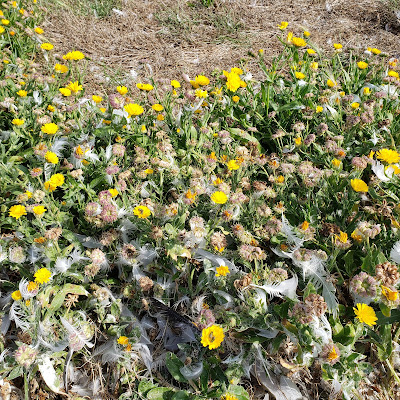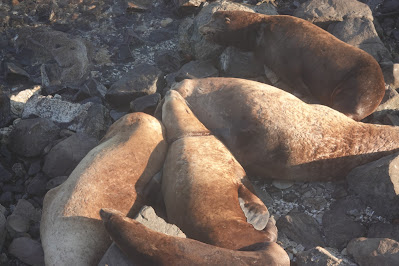Unsurprisingly, I woke to Fogust again, but at least the foghorn was sounding. All the better for getting chores done, right? I also knew that there might be students coming, but wasn't exactly sure of the plan, so thought it best to get things out of the way early. All required duties were out of the way by 8, except for the water test, which has to occur at a specific time, and today, that wasn't after 2 pm. In addition to the fog, the wind was blowing quite strongly, which made me think about what I had brought with me that I hadn't used. All my clothes and all my gadget came into play. I had four pairs of footwear with me for an island you can cross in under 2 minutes. All used. The least used item I brought was a folding chair with a sun/poop roof. I had envisioned myself sitting in it on the solar panel roof, looking out to sea for hours. That didn't happen. It made its way to the roof a couple of times in the first days I was here, but the rest of the time, stayed waiting in the generator room.
I used the last bit of regular milk I had to make my morning cup of tea. I had powdered milk which I had mixed up and used for cereal, but it isn't quite the same in tea. Nomatter. I should have my next cup in Tim's tea in hand before the end of tomorrow. A glance out the window revealed a dark blob in the fog. What was it?
If you guessed sea lion, you are correct! A security breach! He had some up the same way the elephant seals do, using the boat ramp. The Standard Operating Procedures clearly state:
Repeat after me (hand over heart): I will actively
manage the Sealions so that they only have access to the outer edges of the
island and I will do my best to keep Sealions from damaging the infrastructure.
I had to confront the intruder! Fortunately, this one seemed to know the drill and moved on quite easily. While I was at the jetty, despite the fog, I was able to find another branded sea lion. This one, U958, was branded in Astoria, OR, in 2015 and had visited Race Rocks at least once before in 2020.
 |
| U958 from Astoria |
While I was applying the policy, Greg called on the radio and said that three of the group he had on his boat would be staying in the Science Building overnight. Although they were fully independent once set up, there were a few things that needed to be done to get them to that point. Plans change very quickly here.
I had one final project I wanted to do, and it involved bird spikes. I had poked myself on the spikes on the panels earlier on this trip, and there was one particularly problematic section where the gap between new large panels was really too small to properly squeegee the panels. I concluded that the spikes were pointing the wrong way--towards the humans rather than towards the sky. I knew the solution--L brackets to change the direction of the spikes. But where could I find some, and should I really fix this? During my snooping around, I found a roll of steel strapping. Perfect. I made some L brackets and installed them on the panels. Too bad I won't be around to see if they work better on keeping the gulls from fouling these panels, but I hope they make the life of the next ecoguardians a little easier. If so, maybe they'll be inspired to do the rest of the spikes they can reach. It was done in bits and pieces over the day, but by the end of the afternoon, I had the strips on the two panels I had hoped I could get done. We'll see if I love them when I clean the panels tomorrow.
 |
| Before |
 |
| After |
 |
| L brackets made of strapping |
Late morning in the fog, can you guess what happened? If you guessed that the foghorn stopped again, you'd be correct! Are you two for two on today's quiz? It wasn't as foggy as Wednesday, so I was less concerned about anyone running aground. When it didn't restart after a while, I notified the Coast Guard again. I ended up making a couple of trips halfway up the tower to take pictures of the fog gauge, which seems to be at the root of the problem. In dense fog, the gauge was reading all clear. Later in the day, the foghorn restarted, and a check of the gauge showed about the correct visibility. Guess they'll be coming back!
 |
| Fog gauge |
The wind kept rising throughout the day, and was in the high 20s by the evening, and eventually to 38 knots close to midnight. Before sunset, I made a trip up the tower and the sound was very spooky. I managed to catch some shots of Steller's sea lion 882R jumping into the ocean. Lighting wasn't great, but I think the researchers will like the series.
As I approached the ecoguardian house, another breach!! This one right through the electric fence. After returning the sea lion to the correct side of the fence, I now have another task to do on Friday. He may have made it to this side without breaking the fence, but he took it out going back.
 |
| So proud of his accomplishment! |
 |
| His fan club stood by while I adjusted the fence. |
One last evening look at the shorebird beach turned up the expecte Black Turnstones and Surfbirds, one still partially in its breeding plumage. There were also three Short-billed Dowitchers.
 |
| Very pretty Surfbird! |
My plan had been to be all packed up and ready to go on Thursday night except for things I would need on Friday. Last year, a rare bird showed up just as I was packing, making me almost late for my ride back. I didn't want to repeat that. But you know what they say about best laid plans. As I write this, nothing is packed!
Mushu update:
 |
| If there's no sun, there's no point in getting up! |
A few more photos from the day:
 |
| Yup, Fogust |
 |
| Looks clean(ish), but actually it's a whitewashing job. |
 |
| Gifts from the sea. Gulls often bring plastic to shore. |
 |
| Sea lions aren't the only creatures molting. |
 |
| This sea lion is entangled by a rubber band. While they are mobile and healthy, there is no way to catch and free them from the gear. |



































